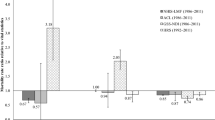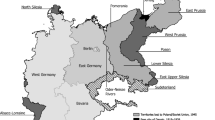Abstract
A great deal of research has focused on factors that may contribute to the Hispanic mortality paradox in the United States. In this paper, we examine the role of the salmon bias hypothesis—the selective return of less-healthy Hispanics to their country of birth—on mortality at ages 65 and above. These analyses are based on data drawn from the Master Beneficiary Record and NUMIDENT data files of the Social Security Administration. These data provide the first direct evidence regarding the effect of salmon bias on the Hispanic mortality advantage. Although we confirm the existence of salmon bias, it is of too small a magnitude to be a primary explanation for the lower mortality of Hispanic than non-hispanic (NH)-White primary social security beneficiaries. Longitudinal surveys that follow individuals in and out of the United States are needed to further explore the role of migration in the health and mortality of foreign-born US residents and factors that contribute to the Hispanic mortality paradox.
Similar content being viewed by others
References
Abraido-Lanza, A. F., Dohrenwend, B. P., Ng-Mak, D. S., & Turner, J. B. (1999). The Latino mortality paradox: A test of the “salmon bias” and healthy migrant hypotheses. American Journal of Public Health, 89(10), 1543–1548.
Ahmed, B., & Robinson, G. (1994). Estimates of emigration of the foreign-born population: 1980–1990. Population Division Working Paper No. 9. US Census Bureau, Washington, DC.
Duleep, H. O. (1994). Social security and the emigration of immigrants. Social Security Bulletin, 57(1), 37–52.
Elo, I. T., & Preston, S. H. (1997). Racial and ethnic differences in mortality at older ages. In L. G. Martin & B. J. Soldo (Eds.), Racial and ethnic differences in the health of older Americans (pp. 10–42). Washington, DC: National Academy Press.
Elo, I. T., Turra, C. M., Kestenbaum, B., & Ferguson, B. R. (2004). Mortality among elderly Hispanics in the United States: Past evidence and new results. Demography, 41(1), 109–128.
Franzini, L., Ribble, J. C., & Keddie, A. M. (2001). Understanding the Hispanic paradox. Ethnicity and Disease, 11(3), 496–518.
Hu, Y. R., & Goldman, N. (1990). Mortality differentials by marital status—an international comparison. Demography, 27(2), 233–250.
Hummer, R. A., Benjamins, M. R., & Rogers, R. G. (2004). Racial and ethnic disparities in health and mortality among the U.S. elderly population. In N. B. Anderson, R. A. Bulatao, & B. Cohen (Eds.), Critical perspectives on racial and ethnic differences in health in late life (pp. 53–94). Washington, DC: National Academy Press.
Jasso, G., Massey, D. S., Rosenzweig, R. S., & Smith, J. P. (2004). Immigrant health, selectivity and acculturation. In N. B. Anderson, R. A. Bulatao, & B. Cohen (Eds.), Critical perspectives on racial and ethnic differences in health in late life (pp. 227–266). Washington, DC: National Academy Press.
Kestenbaum, B. (1988). Social security beneficiaries residing abroad and emigration. Research on Aging, 10(4), 493–498.
Kestenbaum, B. (1997). Recent mortality of the oldest old, from Medicare data. Paper presented at the Population Association of America, Washington, DC.
Kestenbaum, B., & Ferguson, B. R. (2002). Mortality of the extreme aged in the United States in the 1990s. North American Actuarial Journal, 6, 38–44.
Khlat, M., & Courbage, Y. (1996). Mortality and causes of death of Moroccans in France, 1979–91. Population: An English Selection, 8, 59–94.
Lauderdale, D. S., & Kestenbaum, B. (2002). Mortality rates of elderly Asian American populations based on Medicare and social security data. Demography, 39(3), 529–540.
LeClere, F. B., Rogers, R. G., & Peters, K. D. (1997). Ethnicity and mortality in the United States: Individual and community correlates. Social Forces, 76(1), 169–198.
Manton, K. G., & Vaupel, J. W. (1995). Survival after the age of 80 in the United States, Sweden, France, England, and Japan. New England Journal of Medicine, 333(18), 1232–1235.
Markides, K. S., & Eschbach, K. (2005). Aging, migration, and mortality: current status of research on the Hispanic paradox. Journals of Gerontology: Series B, 60B, 68–75.
Markides, K. S., Rudkin, L., Angel, J., & Espino, D. V. (1997). Health status of the Hispanic elderly. In L. G. Martin & B. J. Soldo (Eds.), Racial and ethnic differences in the health of older Americans (pp. 105–162). Washington, DC: National Academy Press.
Marmot, M. G., Adelstein, A. M., & Bulusu, L. (1984). Lessons from the study of immigrant mortality. Lancet, 1(8392), 1455–1457.
NCHS. (2000). Multiple cause of death public use files. 1986–1994 survey years. Dates of death 1986–1996. Hyattsville, MD: NCHS.
Pablos-Mendez, A. (1994). Mortality among Hispanics [letter; comment on: JAMA, 270(20), 2464–2468, 1993 Nov 24] JAMA, 271(16):1237.
Palloni, A., & Arias, E. (2004). Paradox lost: Explaining the Hispanic adult mortality advantage. Demography, 41(3), 385–415.
Palloni, A., & Ewbank, D. C. (2004). Selection processes in the study of racial and ethnic differentials in adult health and mortality. In N. B. Anderson, R. A. Bulatao, & B. Cohen (Eds.), Critical perspectives on racial and ethnic differences in health in late life. Washington, DC: National Academy Press.
Palloni, A., & Morenoff, J. (2001). Interpreting the paradoxical in the Hispanic paradox: Demographic and epidemiological approaches. In M. Weinstein, A. Hermalin, & M. A. Soto (Eds.), Population health and aging: Strengthening the dialogue between epidemiology and demography. New York, NY: New York Academy of Sciences.
Passel, J. S. (2005). Estimates of the size and characteristics of the undocumented population. Report, Pew Hispanic Center, Washington, DC.
Passel, J. S., & Word, D. L. (1980). Constructing the list of Spanish surnames for the 1980 census: An application of Bayes’ theorem. Presented at Annual Meeting of the Population Association of America, Denver, CO, April 10–12.
Reyes, B. I. (1997). Dynamics of immigration: Return migration to Western Mexico. San Francisco, CA: Public Policy Institute of California.
Rosenberg, H. M., Maurer, J. D., Sorlie, P. D., MacDorman, M. F., Hoyert, D. L., Spitler, J. F., & Scott, C. (1999). Quality of death rates by race and Hispanic origin: A summary of current research. Vital and Health Statistics, 2(128), 1–13.
Ross, S. J., Pagan, J. A., & Polsky, D. (2006). Access to health care for migrants returning to Mexico. Journal of Health Care for the Poor and Underserved, 17, 374–385.
Sharma, R. D., Michalowski, M., & Verma, R. B. P. (1990). Mortality differentials among immigrant populations in Canada. International Migration, 28, 443–450.
Sorlie, P. D., Backlund, M. S., Johnson, N. J., & Rogot, E. (1993). Mortality by Hispanic status in the United States. Journal of the American Medical Association, 20, 2464–2468.
Turra, C. M. (2004). Living and dying at older ages: Essays on the Hispanic mortality paradox and the annuity puzzle in the U.S. Ph.D. Thesis, University of Pennsylvania.
U.S. Census Bureau. (2002). Race and Hispanic or Latino origin by age and sex for the United States: 2000 (PHC-T-8). http://www.census.gov/population/www/cen2000/phc-t08.html.
Warren, R., & Peck, J. M. (1980). Foreign-born emigration from the United States, 1960–1970. Demography, 17(1), 71–84.
Word, D. L., & Perkins, R. C. (1996). Building a Spanish surname list for the 1990s—a new approach to an old problem. Technical Working Paper No. 13, US Census Bureau, Washington, DC.
Acknowledgments
This research was supported by Grant AG10168 from the National Institute on Aging to the University of Pennsylvania, Samuel H. Preston, Principal Investigator. We are grateful to Bert Kestenbaum and B. Renee Ferguson of the Social Security Administration for providing us the data used in this study and for their valuable input. We also thank Sam Preston, Bob Hummer, Noreen Goldman, and two anonymous reviewers for their helpful comments. An earlier version of this paper was presented at the Annual Meeting of the Population Association of America, Philadelphia, PA, April 2005.
Author information
Authors and Affiliations
Corresponding author
Rights and permissions
About this article
Cite this article
Turra, C.M., Elo, I.T. The Impact of Salmon Bias on the Hispanic Mortality Advantage: New Evidence from Social Security Data. Popul Res Policy Rev 27, 515–530 (2008). https://doi.org/10.1007/s11113-008-9087-4
Received:
Accepted:
Published:
Issue Date:
DOI: https://doi.org/10.1007/s11113-008-9087-4




